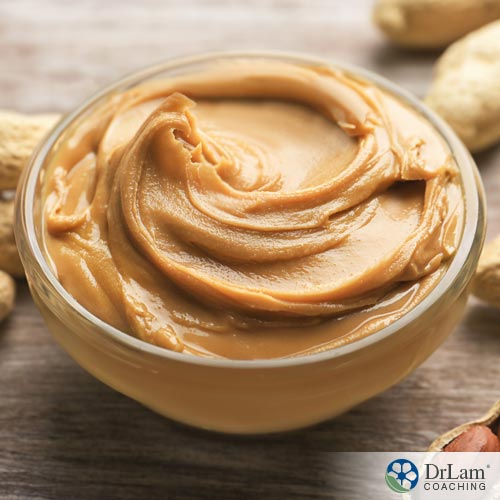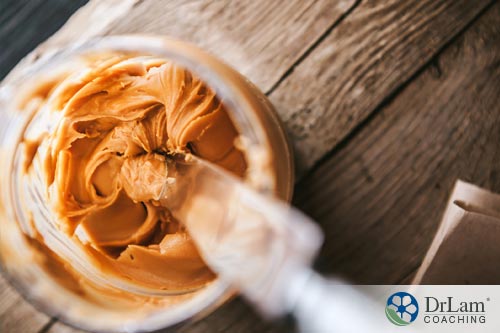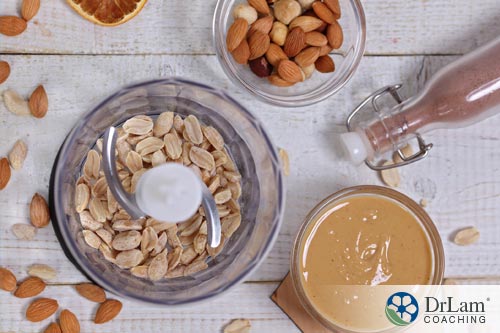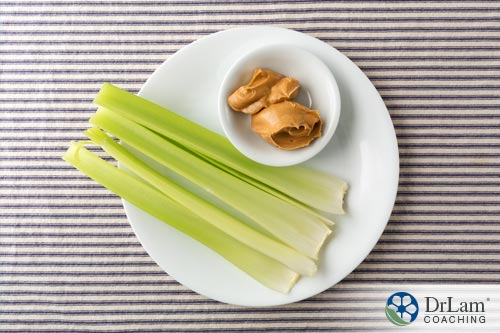There are a lot of misconceptions regarding peanut butter facts. Is peanut butter healthy? Can it cause weight gain? Can it trigger allergies? Peanut butter is a very popular ingredient in various healthy snack recipes, but there are both positive and negative health effects of consuming this tasty spread.
 Peanuts taste great, but let’s admit it, peanut butter tastes way better. And it’s incredibly easy to make your own peanut butter.
Peanuts taste great, but let’s admit it, peanut butter tastes way better. And it’s incredibly easy to make your own peanut butter.
If you have never made a homemade peanut butter, you won’t believe how ridiculously easy it is. Just get roasted peanuts, some sweetener like honey or agave, and a bit of salt and grind in a blender or food processor until it turns into peanut butter. It may take several minutes, but not much work on your part.
Unfortunately, commercial peanut butter brands are often not just peanut butter. They contain sugar, hydrogenated stabilizers, and other nasty ingredients to make the peanut butter sweet or prevent the oils from separating out.
This article focuses on the health benefits of homemade peanut butter. In general, the health benefits of typical peanuts are similar to the health benefits of peanut butter, since it is simply ground peanuts.
Peanut butter is a balanced source of energy that provides all the three macronutrients. Based on the USDA National Nutrient Database, a 100 gram serving of peanut butter provides:
Peanut butter facts: Fat content consists of 20% saturated, 50% monounsaturated and nearly 30% polyunsaturated, which is mostly the omega-6 fat, linoleic acid.
Peanut butter is also packed with vital vitamins and minerals. A 100 gram serving of peanut butter provides loads of essential micronutrients including:
Like other real, whole foods, peanut butter contains more nutrients beyond the usual vitamins and minerals. Peanut butter is rich in antioxidants such as p-coumaric acid, which is believed to reduce the risk of stomach cancer. It also has decent amounts of resveratrol, beta-sitosterol, and trace amounts of Q10, which are important nutrients that have cancer-preventive properties.
Rich in protein. Peanut butter provides a high amount of protein at 25 to 30 grams (per 100 gram), which are broken down into amino acids. They are used in every cell for building new cells and muscle repair.
Lowers cholesterol level. The fat present in peanut butter is nearly the same as the fats present in olive oil. It contains both monounsaturated fats and polyunsaturated fats. Since these fats aren’t saturated, they’re healthy to eat without putting your heart at risk. These healthy fats help lower the bad cholesterol, or low-density lipoprotein, while increasing the amount of circulating good cholesterol, or high-density lipoprotein.
 Antioxidants. Peanut butter offers loads of antioxidant benefits due to the presence of niacin, thiamine, folate, pantothenic acid, riboflavin, and pyridoxine. Another antioxidant found in peanuts is resveratrol, a polyphenolic antioxidant found to be effective in preventing the risk of certain types of cancer, as well as controlling heart disease, viral or fungal infections, degenerative nerve diseases, and Alzheimer’s disease.
Antioxidants. Peanut butter offers loads of antioxidant benefits due to the presence of niacin, thiamine, folate, pantothenic acid, riboflavin, and pyridoxine. Another antioxidant found in peanuts is resveratrol, a polyphenolic antioxidant found to be effective in preventing the risk of certain types of cancer, as well as controlling heart disease, viral or fungal infections, degenerative nerve diseases, and Alzheimer’s disease.
May help prevent type II diabetes. Consuming peanut butter is also beneficial for lowering the risk of developing type II diabetes. Unsaturated fats present in peanuts have been found to improve insulin sensitivity. A study on peanut butter consumption and the risk of type II diabetes showed the potential benefit of higher peanut butter and nut intake in lowering the risk of type II diabetes in women. However, to prevent an increase in caloric intake, nuts and peanut butter can be used as a substitute for consumption of refined grains and processed meats.
Rich source of vitamins. Peanut butter is rich in many vitamins that are required for the body to work properly. Vitamin E present in peanut butter is crucial for the body to counter fat blockages in the blood vessels.
May help prevent cancer. Peanut butter is a good source of B-sitosterol, a phytonutrient with great cancer-fighting properties, specifically for prostate, colon, and breast cancers.
Rich source of magnesium. One of the most interesting peanut butter facts is that it provides 190 mg of magnesium in every 100 grams, which is 42% of the daily recommended value for magnesium. Magnesium is crucial for bone and muscle development and for the immune system. It also helps regulate blood sugar and blood pressure levels. Magnesium is necessary for more than 300 biochemical reactions in the body that are very important for survival. Magnesium is also a natural muscle relaxant and can help the body calm down, making it useful in early adrenal fatigue stages.
Rich source of potassium. Peanut butter is rich in potassium, which serves as an electrolyte to keep fluid balanced in the body. A necessary balance to sodium levels in the body, potassium does this in a way that doesn’t further pressure the cardiovascular system. Potassium is a heart-friendly element present in rich quantity in peanut butter.
May lower the risk of gallstones. A gallstone is a solid, hardened deposit that forms in the gallbladder. While the main cause of gallstones is still unknown, they may form when the bile contains too much cholesterol or bilirubin, or if the gallbladder does not empty property. One study showed that women who consume nuts and peanut butter regularly had reduced risk of developing gallstones.
Loaded with dietary fiber. A 100 gram serving of peanut butter contains 8 grams of dietary fiber, which is vital for the healthy movement of the digestive tract, and which can counter various diseases and health problems such as diabetes, constipation, high cholesterol, and heart diseases.
 Most of those trying to lose weight place peanut butter on their “No-No” list because of its high calorie content. However, nutrition expert Dr. Walter C. Willett of the Harvard Heart Letter's editorial board says otherwise.
Most of those trying to lose weight place peanut butter on their “No-No” list because of its high calorie content. However, nutrition expert Dr. Walter C. Willett of the Harvard Heart Letter's editorial board says otherwise.
The saturated fat present in peanut butter does not immediately categorize this food as ‘unhealthy’. Wheat germ, olive oil, and tofu, which are all considered healthy foods, all contain some saturated fat. What determines how good a specific food is for your health is that entire package of nutrients, not just one or two.
A two-tablespoon serving of peanut butter contains 3.3 grams saturated fat and 12.3 grams unsaturated fat. In terms of the ratio of saturated to unsaturated fat, that puts peanut butter on the same level as olive oil.
Saturated fat isn’t as terrible as it is often viewed. To neutralize saturated fat in food, the body increases the level of protective HDL. Some saturated fat is fine when taken in moderation. However, eating a lot promotes atherosclerosis, the process of fat accumulation on arterial walls, which is behind most cardiovascular diseases.
Of the many peanut butter facts, there are both nutritional and health benefits. However, that is not the only side of this food.
Omega-6 Fat. The modern diet contains too many omega-6 fats and inadequate amounts of omega-3 fats. omega-6 fats promote inflammation while omega-3 fats counter it. Peanuts contain exceedingly high amounts of omega-6 fatty acid, about 30%, in the form of linoleic acid, and very little omega-3, causing an imbalance in the ratio. Excessive intake of omega-6 polyunsaturated fats and high omega-6/omega-3 ratio promote many negative health effects such as inflammatory diseases and autoimmune disorders.
Adrenal fatigue can sometimes result as the body battles inflammation. Cortisol is an anti-inflammatory hormone that is created by your adrenal glands. Increasing inflammation in your body through diet and too much omega-6 in peanut butter could potentially increase inflammation and stress your adrenal glands as well.
To make peanut butter healthy for you, you need to increase your intake of omega-3 fats to balance your fatty acid ratio. Add a little flaxseed oil or consume omega-3 rich fish such as salmon or sardines when you eat peanut butter on a regular basis.
Contains mold that can cause allergies. Another issue is that peanuts are grown in very moist ground that may contain mold or mycotoxins. Peanuts tend to be colonized by this ubiquitous fungus called Aspergillus which releases aflatoxins, a highly carcinogenic and toxic mold.
Toxic mold can cause many health issues. While humans are quite resistant to the short-term effects of aflatoxins, the long-term effect is still unknown at this point. Aside from depression, mold is one of the major reasons why many kids today have inflammatory immune reactions or food allergies when they consume anything that has peanuts.
According to one study, processing peanuts into peanut butter lowers the aflatoxins by 89%. In addition, the USDA checks the level of aflatoxins in food, making sure that they won’t go beyond the recommended limits.
In general, most nutritionists won’t recommend peanut butter as one of the main food sources in your diet as peanut butter facts conclude that it is incredibly high in calories. It is fine in small portions now and then. The biggest concern with peanut butter is that it is so hard to resist.
Have it in small portions. Eating only a small amount probably won’t cause any harm, unless you are allergic to peanuts. A serving size is two tablespoons.
 Make your own. Unfortunately, many of the peanut butters sold in stores are unhealthy, containing hydrogenated oils or made from non-organic nuts. This further augments your intake of omega-6 fats, which can mess up your health. The best way to enjoy peanut butter to make your own natural, organic peanut butter instead.
Make your own. Unfortunately, many of the peanut butters sold in stores are unhealthy, containing hydrogenated oils or made from non-organic nuts. This further augments your intake of omega-6 fats, which can mess up your health. The best way to enjoy peanut butter to make your own natural, organic peanut butter instead.
When making homemade peanut butter, be sure that you purchase your ingredients from a certified organic brand. Ideally, the type of peanuts to buy is Jungle peanuts or Valencia peanuts. These varieties of peanuts are not commonly grown in the moist ground but on higher up or in bushes off the ground. This eliminates the concern for mold.
Also, Valencia peanuts have more monounsaturated fats that can lower triglycerides as well as the nine essential amino acids. This variety is also rich in resveratrol.
Increase your omega-3 intake. As said, peanut butter contains high amounts of omega-6 fatty acid, which may create an imbalance in your omega-6/omega-3 ratio. To make it healthy for you, you need to consume omega-3 fats in order to balance it out. You can take an omega-3 fish oil supplement or flaxseed oil when consuming peanut butter.
Can I include peanut butter in my adrenal fatigue diet?
Yes, of course, but with limits.
The adrenal fatigue diet is a specialized diet full of nutrient-dense foods that aim to speed up the recovery from Adrenal Fatigue Syndrome (AFS). The bulk of the diet consists of fresh vegetables, making up 30 to 40% of the diet and half of these must be raw. Also, it suggests eating 10 to 20% from whole grains, 10 to 15% from whole fruits, 10 to 20% from legumes and beans, 20 to 30% from seeds and nuts, and 20 to 30% from animal sources.
What’s interesting with peanuts is that, though ‘nut’ may be part of its name, peanut butter facts have proved that it is actually a legume. This makes peanuts a member of the family of plants that includes beans, soybeans, and lentils.
There are many creative ways to incorporate peanut butter into your diet, but it should be used in moderation. If you have adrenal fatigue, it’s always a good idea to consult with your primary medical practitioner before adjusting your diet.
 Perfect for snacking. Use it as a dip for fresh vegetables. It goes really well with celery, which contains only 10 calories per stalk or baby carrots, which are high in dietary fiber and vitamin A yet low in calories. Be sure to measure the amount of peanut butter you’ll eat and put the jar away.
Perfect for snacking. Use it as a dip for fresh vegetables. It goes really well with celery, which contains only 10 calories per stalk or baby carrots, which are high in dietary fiber and vitamin A yet low in calories. Be sure to measure the amount of peanut butter you’ll eat and put the jar away.
In smoothies and shakes. Peanut butter can add a flavorful punch to your green smoothie or shake. Blend it with kale, spinach, yogurt, and flax for a powerful burst of healthy calcium, protein, and fats.
In porridge. Add a nutty twist to your ordinary oatmeal or cornmeal porridge by topping with a tablespoon of peanut butter.
© Copyright 2018 Michael Lam, M.D. All Rights Reserved.
This is one of most interesting peanut butter facts, did you know there’s a type of phobia of getting peanut butter stuck at the roof of your mouth? It’s called arachibutyrophobia.
